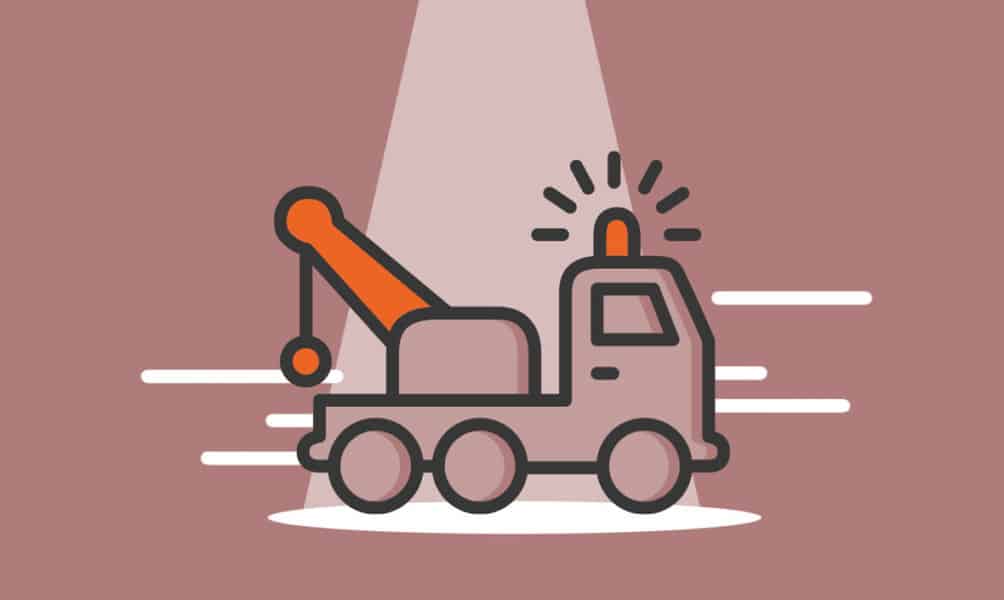
Carolyn Young is a business writer who focuses on entrepreneurial concepts and the business formation. She has over 25 years of experience in business roles, and has authored several entrepreneurship textbooks.
David has been writing and learning about business, finance and globalization for a quarter-century, starting with a small New York consulting firm in the 1990s.
Published on February 16, 2022

$80,000 - $600,000 p.a.
$55,000 - $120,000 p.a.
When starting your roadside assistance business, keep these essential aspects in mind:
![]()
Interactive Checklist at your fingertips—begin your roadside assistance business today!
You May Also Wonder:
Can a roadside assistance be profitable?
You can make $100 to $125 per tow, sometimes more, and you can charge up to $300 for some services. This can add up to several hundred dollars or more per day, so you can definitely make good money.
How can I create a brand identity for my roadside assistance business?
To create a brand identity for your roadside assistance business, start by defining your target market and unique selling points. Develop a professional logo and visual identity that reflects reliability and trustworthiness. Create a compelling tagline or mission statement that communicates the value you provide. Use consistent branding across your website, marketing materials, and service vehicles. Incorporate your brand values into every customer interaction to build a strong and recognizable brand identity.
How can I attract clients and market my roadside assistance services?
To attract clients and market your roadside assistance services, utilize online platforms and social media to showcase your services and expertise. Optimize your website for search engines to improve online visibility. Offer competitive pricing packages and promotions to attract new clients. Network with local auto repair shops, insurance companies, and vehicle dealerships to build relationships and obtain referrals. Utilize targeted online advertising, such as local directories or pay-per-click campaigns, to reach potential clients in your service area.
What safety measures should I take while providing roadside assistance?
Implement safety protocols and provide proper training to your staff. Equip service vehicles with safety equipment such as warning triangles, reflective vests, and emergency road flares. Adhere to traffic laws and maintain situational awareness while working on the roadside.
What types of roadside assistance services can a business provide?
A roadside assistance business can provide various services, including battery jump-starts, tire changes, fuel delivery, lockout assistance, vehicle towing, and vehicle extrication from mud or snow. Additionally, some businesses offer on-the-spot minor repairs, spare key assistance, or transportation for stranded individuals.
Can I start roadside assistance on the side?
Yes, it is possible to start a roadside assistance business on the side. Starting part-time allows you to test the market, build your client base, and refine your services while maintaining other commitments. However, ensure that you have the necessary resources, such as reliable vehicles and proper insurance coverage. Develop a flexible schedule and manage your availability to accommodate roadside assistance requests.
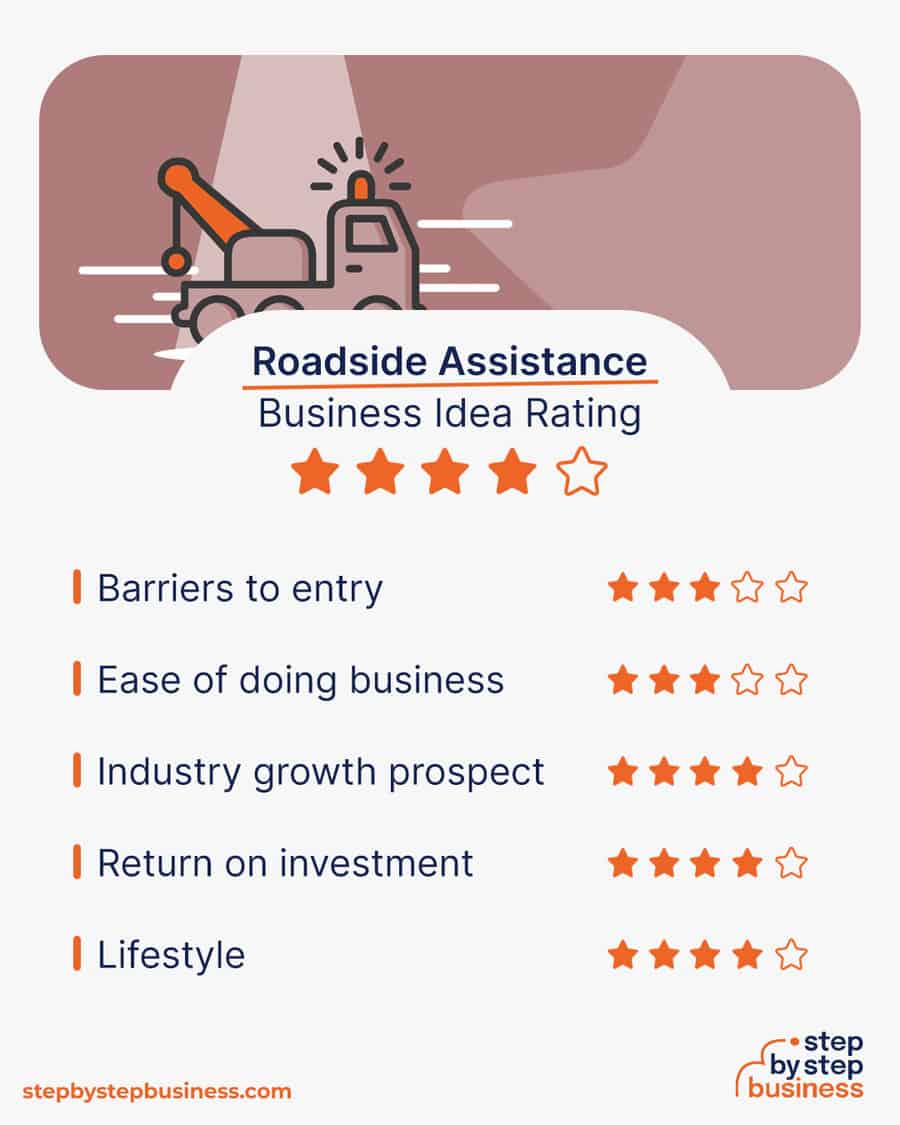
Starting a roadside assistance business has pros and cons to consider before deciding if it’s right for you.
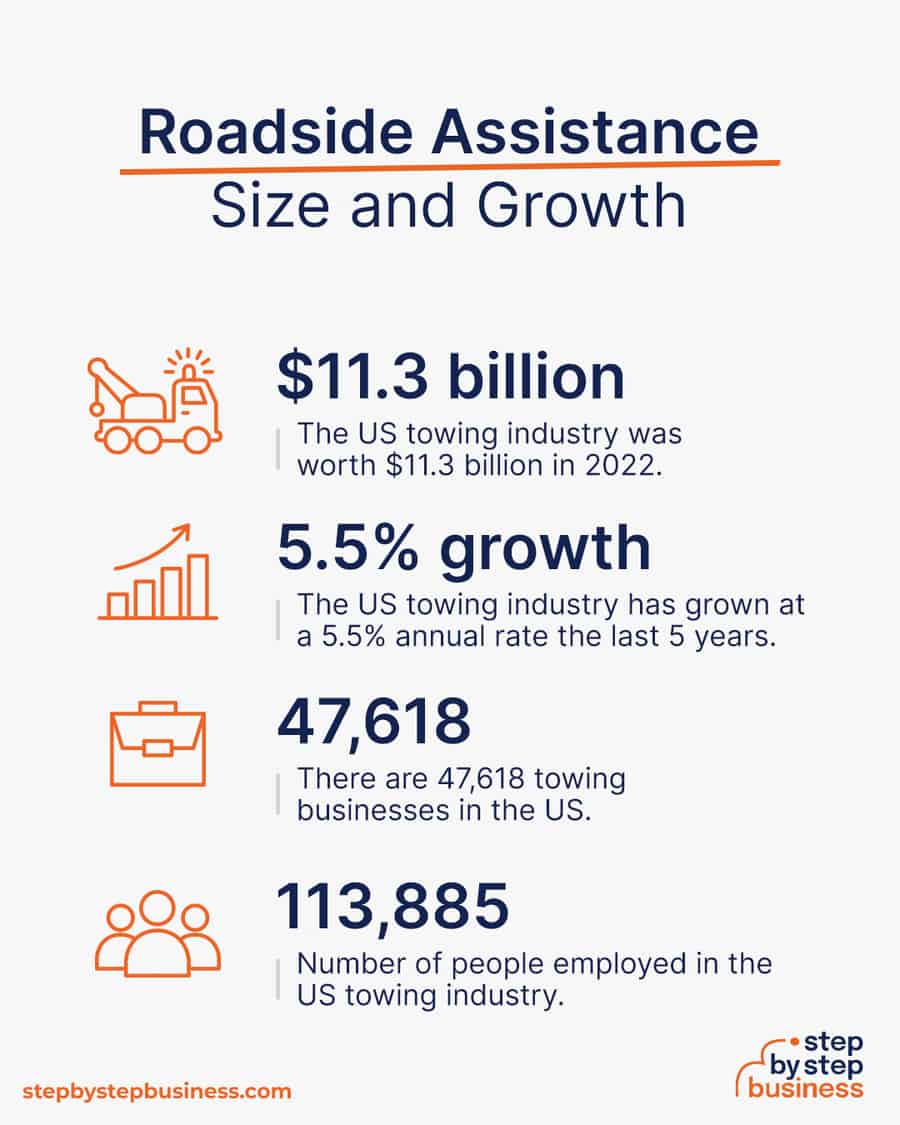
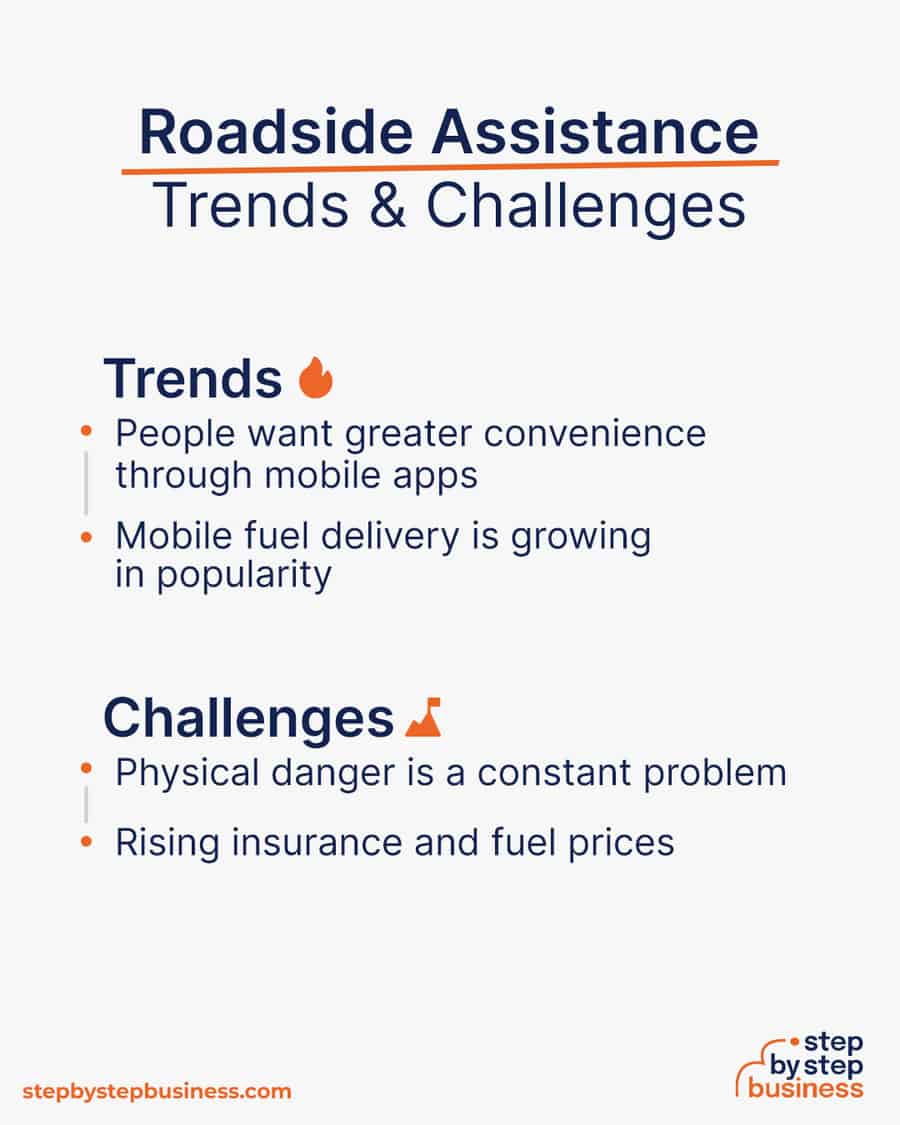
Trends in the roadside assistance industry include:
Challenges in the roadside assistance industry include:
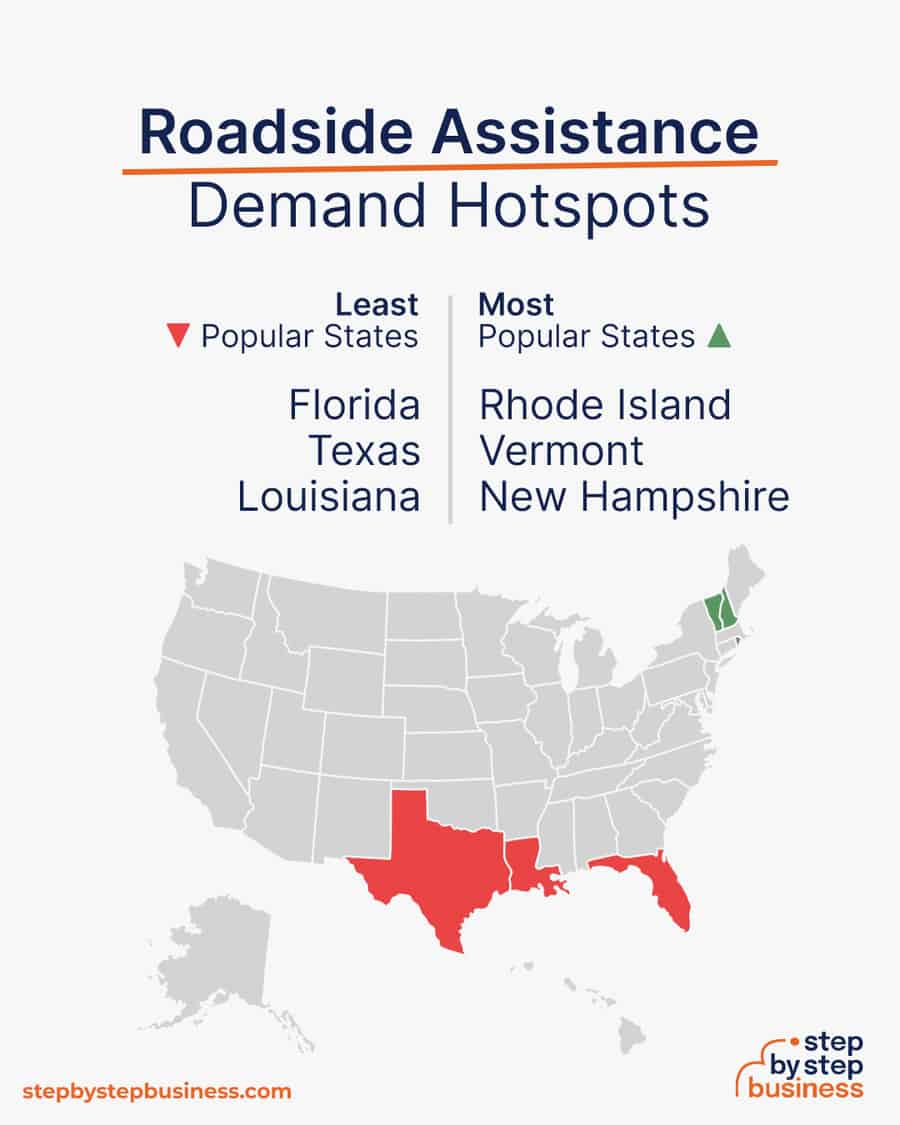
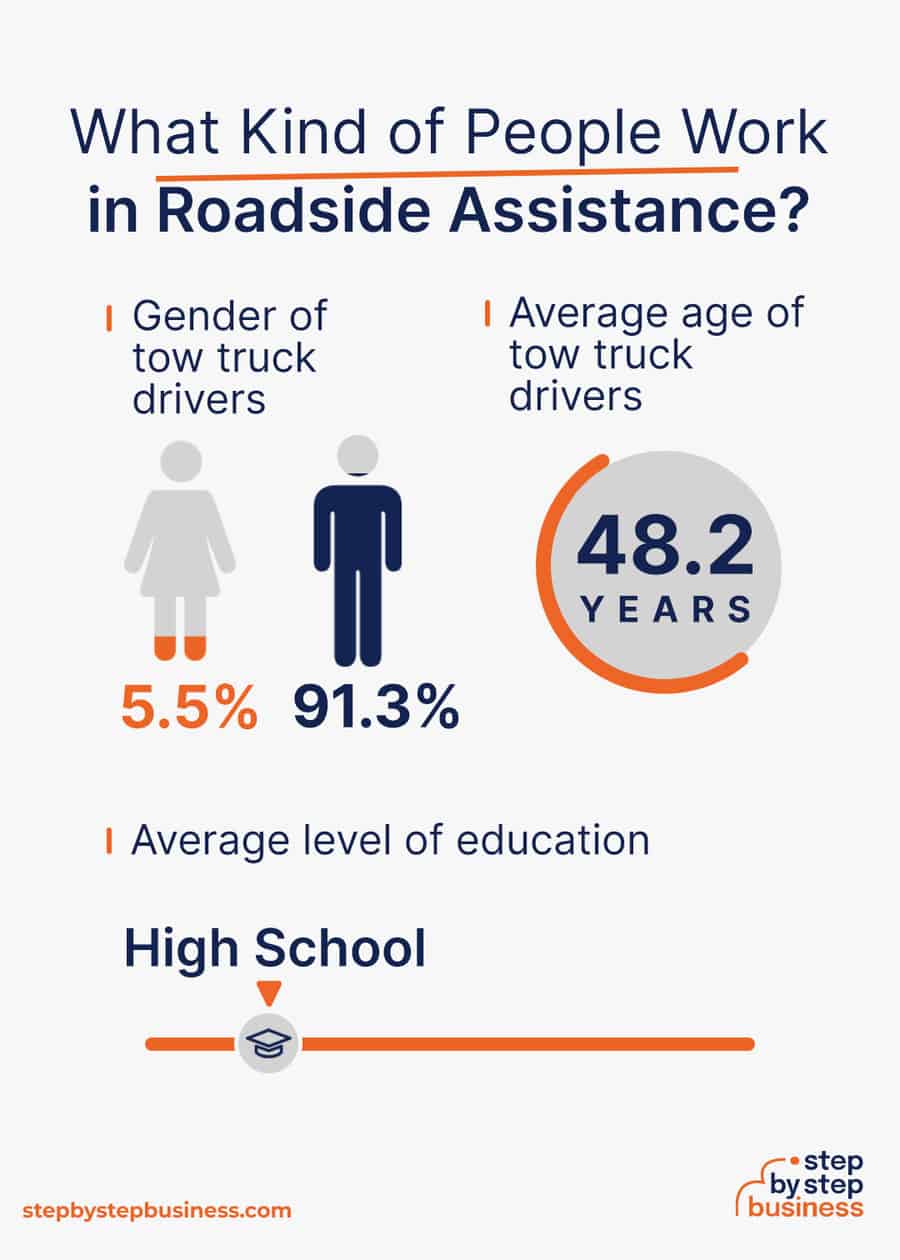
Startup costs for a roadside assistance business range from $8,500 – $17,000. The main expenses are for the down payment on a tow truck and tools. You can also take online courses and learn to be a tow truck driver in just 2 weeks for about $100.
You’ll need a handful of items to successfully launch your roadside assistance business, including:
| Start-up Costs | Ballpark Range | Average |
|---|---|---|
| Setting up a business name and corporation | $150 - $200 | $175 |
| Business licenses and permits | $100 - $300 | $200 |
| Insurance | $100-$300 | $200 |
| Business cards and brochures | $200 - $300 | $250 |
| Website setup | $1,000 - $3,000 | $2,000 |
| Tow truck down payment | $5,000 - $10,000 | $7,500 |
| Tools | $2,000 - $3,000 | $2,500 |
| Total | $8,550 - $17,100 | $12,825 |
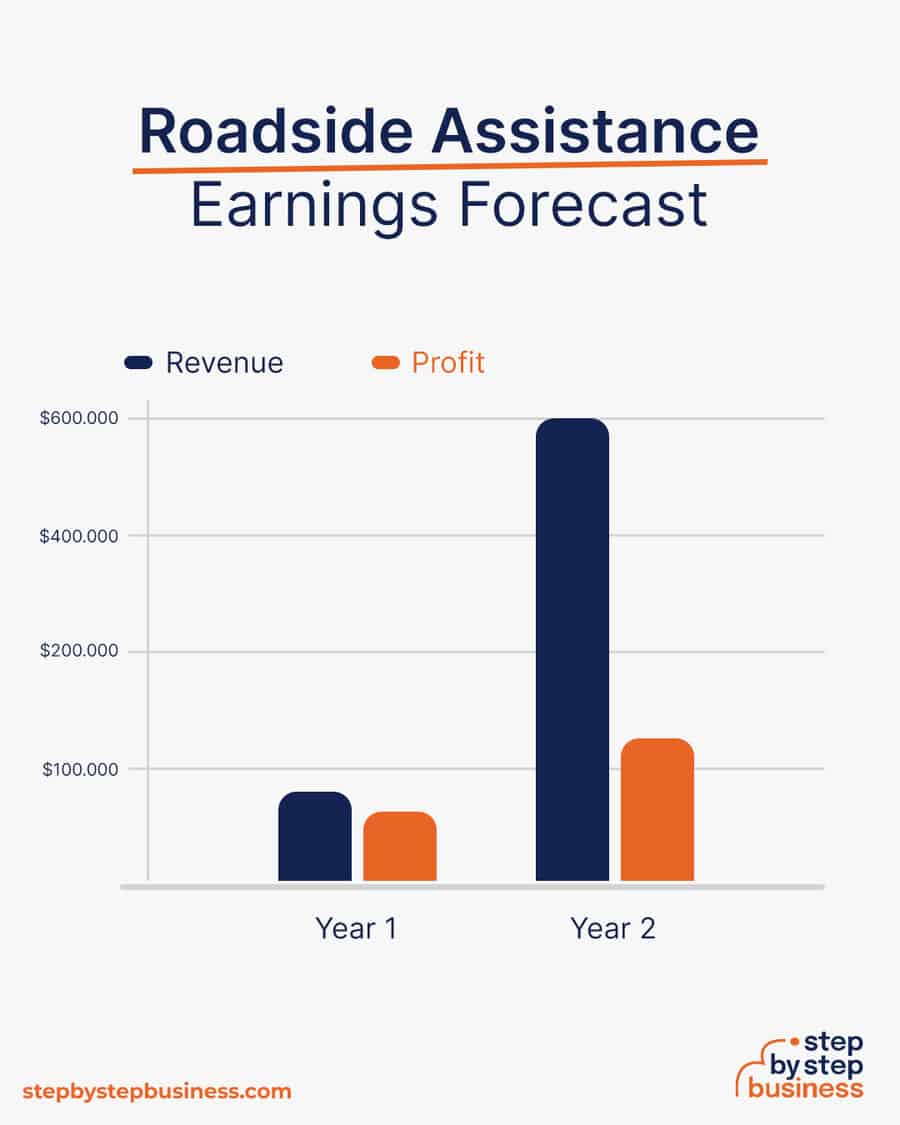
The average price of a tow is about $110, which includes a $75 hook-up charge and $2-$4 per mile. Other services might cost from $50 to $300. Your profit margin after fuel and insurance should be about 70%.
In your first year or two, you could work from home and respond to two calls a day, bringing in more than $80,000 in annual revenue. This would mean over $55,000 in profit, assuming that 70% margin. As your business gains traction, the daily number of roadside services could climb to 15. At this stage, you’d add trucks, rent commercial space, and hire drivers and other staff, reducing your profit margin to 20%. With annual revenue of $600,000, you’d make a tidy profit of $120,000.
There are a few barriers to entry for a roadside assistance business. Your biggest challenges will be:
If you’re still not sure whether this business idea is the right choice for you, here are some related business opportunities to help you on your path to entrepreneurial success.
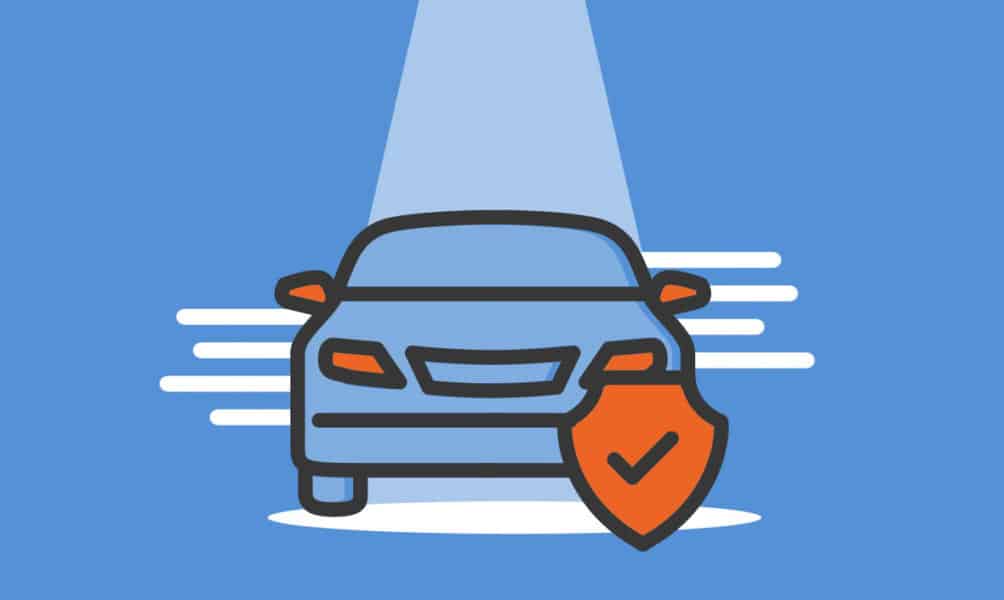
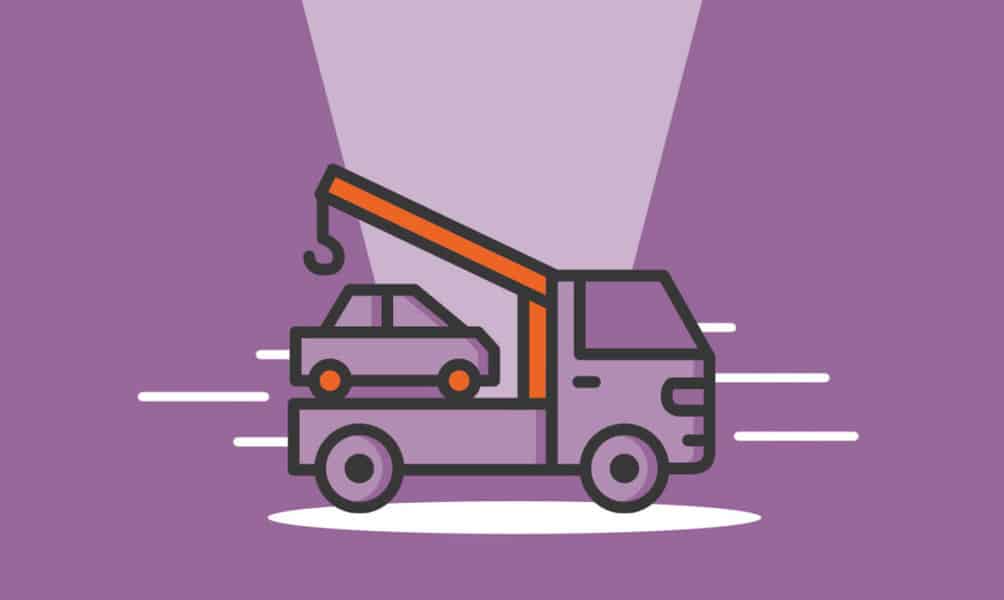
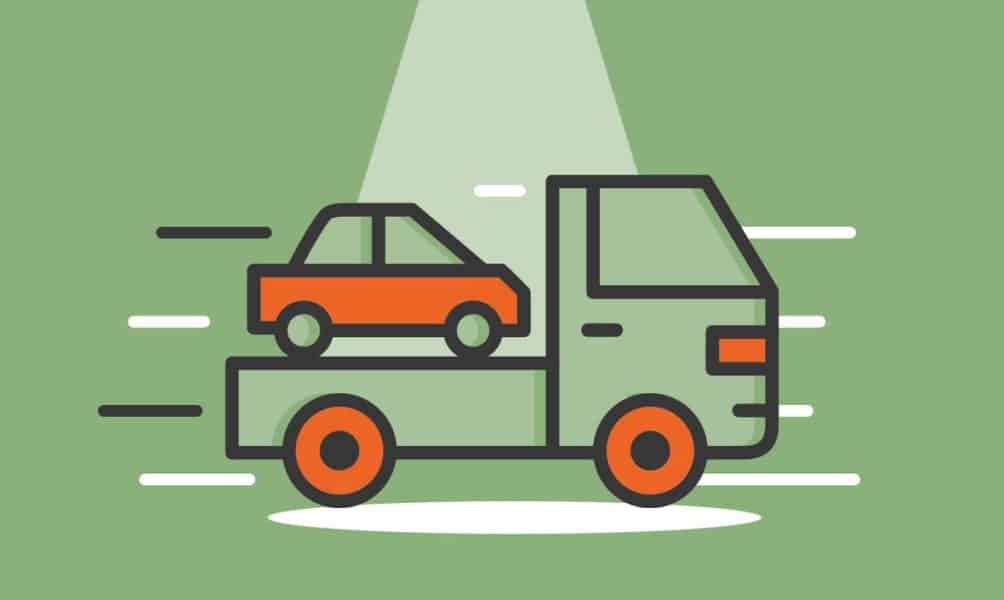
Now that you know what’s involved in starting a roadside assistance business, it’s a good idea to hone your concept in preparation to enter a competitive market.
Market research will give you the upper hand, even if you’re already positive that you have a perfect product or service. Conducting market research is important, because it can help you understand your customers better, who your competitors are, and your business landscape.
Research roadside assistance businesses in your area to examine their services, price points, and customer reviews. You’re looking for a market gap to fill. For instance, maybe the local market is missing a 24-hour roadside fuel delivery service.
![]()
You might consider targeting a niche market by specializing in a certain aspect of your industry, such as charging batteries or changing tires.
This could jumpstart your word-of-mouth marketing and attract clients right away.
Your services will depend on your skills and equipment but could include:
The price of towing is generally a $75 hook-up fee plus $2 to $4 per mile. Prices for other services range from $50 to $300. Your ongoing expenses will be for fuel and insurance when you’re working as a solopreneur, so you should aim for a profit margin of about 70%.
Once you know your costs, you can use this Step By Step profit margin calculator to determine your mark-up and final price points. Remember, the prices you use at launch should be subject to change if warranted by the market.
Your target market will be extremely broad. You should spread out your marketing to sites like TikTok, Instagram, Facebook, and LinkedIn. You could also go to your local police department to get added to their referral list.
In the early stages, you may want to run your business from home to keep costs low. But as your business grows, you’ll likely need to hire workers for various roles and may need to rent out an office. Find commercial space to rent in your area on sites such as Craigslist, Crexi, and Instant Offices.
When choosing a commercial space, you may want to follow these rules of thumb:
Here are some ideas for brainstorming your business name:
Once you’ve got a list of potential names, visit the website of the US Patent and Trademark Office to make sure they are available for registration and check the availability of related domain names using our Domain Name Search tool. Using “.com” or “.org” sharply increases credibility, so it’s best to focus on these.
Powered by GoDaddy.com
Finally, make your choice among the names that pass this screening and go ahead with domain registration and social media account creation. Your business name is one of the key differentiators that sets your business apart. Once you pick your company name, and start with the branding, it is hard to change the business name. Therefore, it’s important to carefully consider your choice before you start a business entity.
Here are the key components of a business plan:
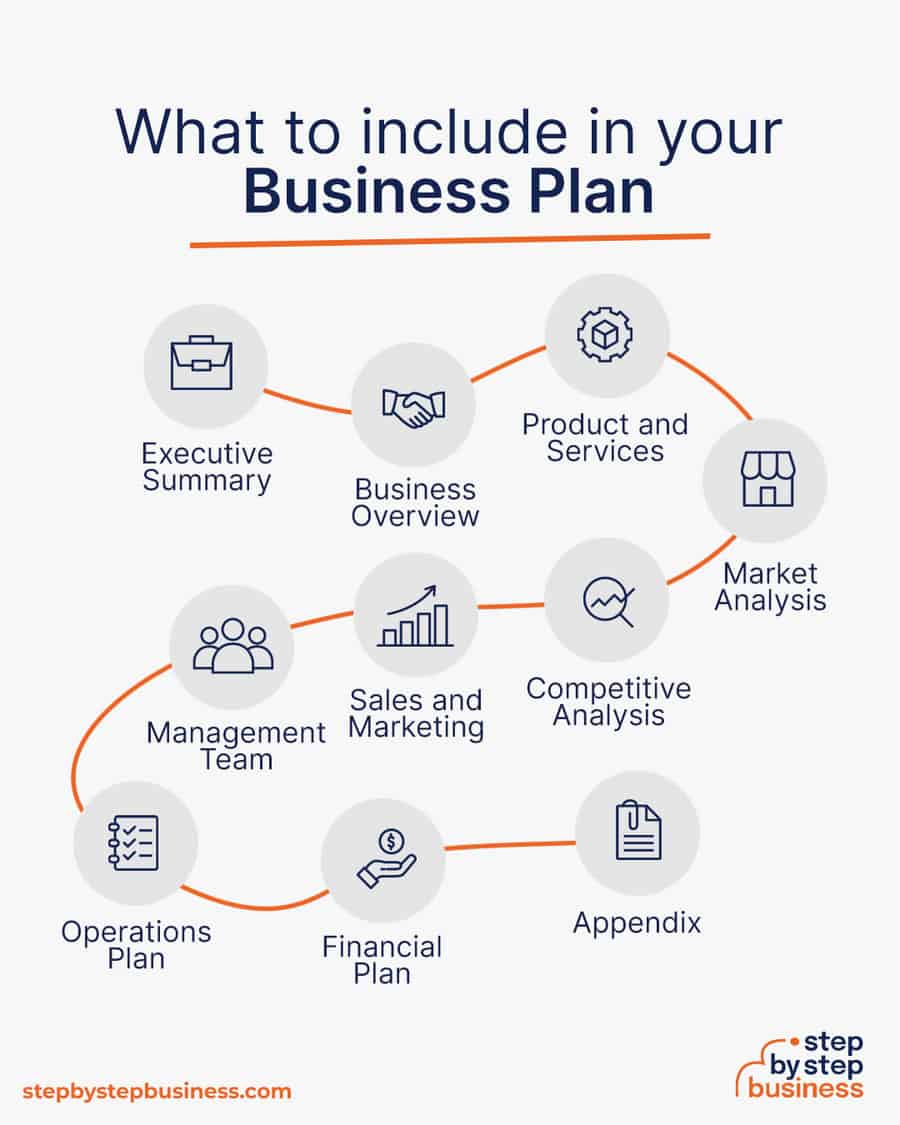
If you’ve never created a business plan, it can be an intimidating task. You might consider hiring a business plan specialist to create a top-notch business plan for you.
Registering your business is an absolutely crucial step — it’s the prerequisite to paying taxes, raising capital, opening a bank account, and other guideposts on the road to getting a business up and running.
Plus, registration is exciting because it makes the entire process official. Once it’s complete, you’ll have your own business!
Your business location is important because it can affect taxes, legal requirements, and revenue. Most people will register their business in the state where they live, but if you’re planning to expand, you might consider looking elsewhere, as some states could offer real advantages when it comes to roadside assistance businesses.
If you’re willing to move, you could really maximize your business! Keep in mind, it’s relatively easy to transfer your business to another state.
Business entities come in several varieties, each with its pros and cons. The legal structure you choose for your roadside assistance business will shape your taxes, personal liability, and business registration requirements, so choose wisely.
Here are the main options:
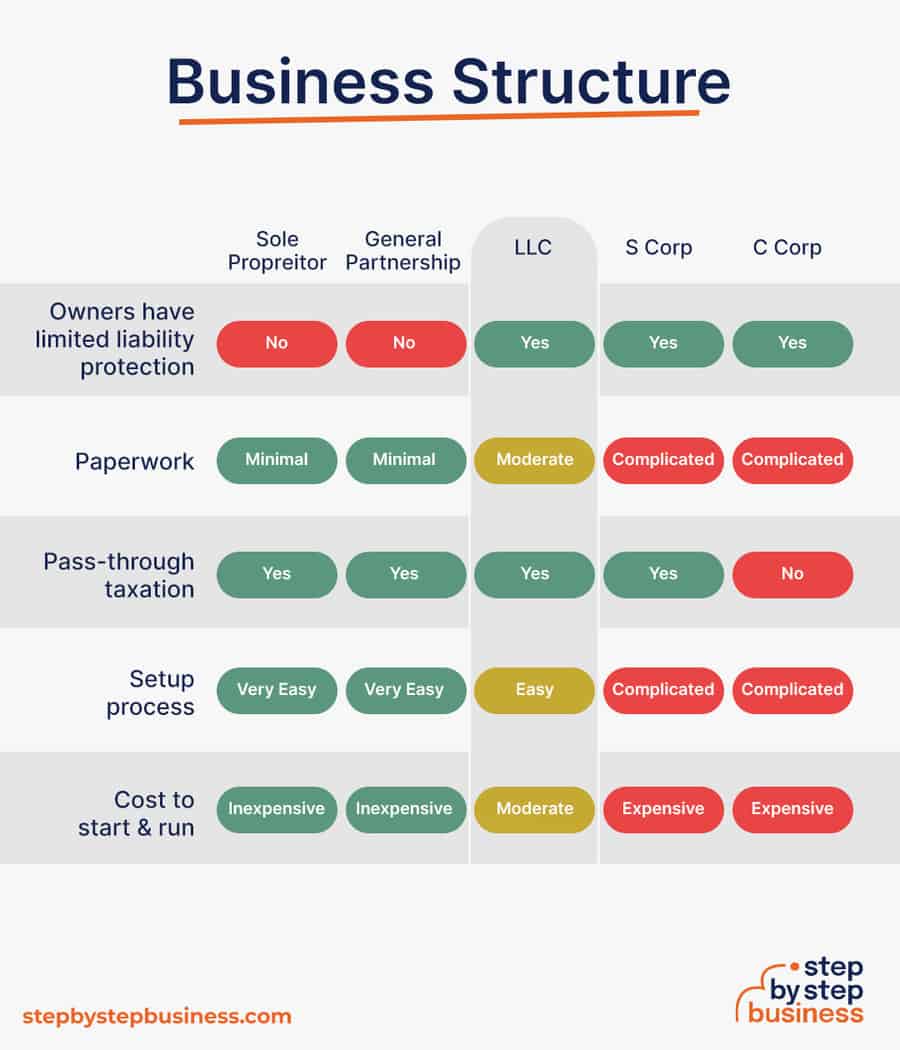
We recommend that new business owners choose LLC as it offers liability protection and pass-through taxation while being simpler to form than a corporation. You can form an LLC in as little as five minutes using an online LLC formation service. They will check that your business name is available before filing, submit your articles of organization, and answer any questions you might have.